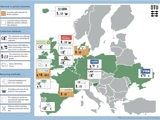Overall project purpose
The overall goal in the M-RRS project is to increase reuse and recycling of mattresses. Currently, approximately 450,000 mattresses are discarded yearly in Denmark, and at least 35 million in the EU. Establishing a mattress take-back system in Denmark can be part of contributing to the goal of increased recycling and is currently being developed. Providing information on existing take-back systems across Europe can provide insights and inspiration for developing an effective mattress take-back system in Denmark.
What did we do?
Our research focused on examining mattress take-back systems in Europe through desk research and expert interviews. The main objective was to understand the different approaches countries employ in recycling mattresses and to identify leading practices that can be potentially implemented in Denmark's mattress recycling initiatives. Desk research involved analyzing reputable sources like "DTU Find it" and "Google". Expert interviews with Tom Mikkelsen from DanFoam/TempurSealy validated our findings and contributed crucial insights. Seventeen different mattress take-back systems in Europe were analyzed.
A detailed overview of the systems can be found here
Key findings
From the research, these were some of the main findings:
- Variety of take-back system solutions: Our investigation revealed diverse approaches to mattress recycling, including both national or private systems, or a combination of both. Within the analysis of 17 take-back systems, three countries were highlighted as leading within the field: France with Écomaison, Holland with RetourMatras, and Belgium with Valumat. All showcasing notable initiatives in mattress recycling. All take-back solutions are illustrated on Figure 1.
- Various collection methods/programs: The systems displayed diverse collection methods, such as designated collection points, home pickups, and cooperation with furniture stores. This illustrates flexibility and adaptability of the different collection methods/programs.
- Material separation for recycling: Processes involved the separation of materials like foam, textiles, and metals, enabling the reutilization of these materials for various purposes.
- RetourMatras is the leader in recycling: Due to its innovative technology within methods for recycling of mattresses.
- New solutions are still needed: Even though many mattresses are collected through the identified systems, approximately 35 million mattresses are still thrown out in Europe every year. This calls for new innovative take-back systems and solutions.
Click the image to enlarge
What are the next steps?
This research’s findings provide valuable insights into the European landscape of mattress recycling, offering a roadmap for Denmark and other regions aspiring to enhance their sustainability efforts through efficient mattress recycling programs. To develop an effective and innovative mattress take-back system in Denmark, inspiration from existing solutions may provide a good base. In addition, more innovative solutions are needed to increase the degree of reuse and recycling of mattresses. Some of the things that should be further investigated:
- Identify optimal take-back systems and collection methods that cover both locally, nationally, and globally discarded mattresses. The system should be flexible and adaptable to different user needs, and the proper collection method should be identified: Through designated collection points? Home pickups? Cooperation with furniture stores/secondhand stores? Something else?
- Collaborative partnerships: Foster partnerships with stakeholders, including industry experts and government bodies, to establish sustainable mattress recycling strategies.
- Technological advancements: Explore innovative technologies utilized in European countries for mattress recycling and assess their feasibility for implementation in Denmark.

